By:
- Kim McDonald
Published Date
By:
- Kim McDonald
Share This:
Lord of the Bees
Biology grad student’s extensive collection of region’s bees provides critical clues to long-term impact of current drought on natural ecosystems
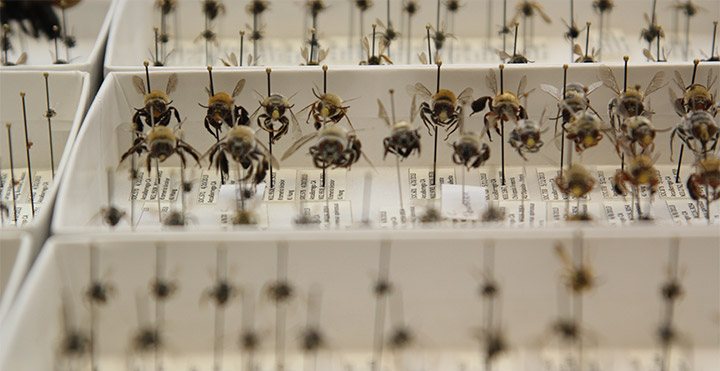
James Hung has collected more than 17,000 wild bees from coastal, desert and mountain areas of San Diego County. But many of his specimens bear little resemblance to the honey bees we normally think of as bees. To the casual observer, his bee collection looks more like a menagerie of Insects Gone Wild—gnat-sized bugs with long snouts, gigantic black bees and curious iridescent creatures with termite-like wings.
“When I first started studying native bees, I really didn’t know that there was this much diversity,” admits Hung, a doctoral student in UC San Diego’s Division of Biological Sciences, pointing to the thousands of San Diego bees he’s carefully pinned and catalogued in the dozens of wood-framed and cardboard boxes stacked in his laboratory. “I thought they all looked like honey bees, more or less. But the more I studied them, the more different forms I’ve seen.”
Since he began his thesis research project three years ago to determine the impact of development and habitat fragmentation on San Diego’s native bee populations—one of the most diverse in the world—the 25-year-old grad student has amassed one of the most complete collections of these little-known, but ecologically important insects from one of the world’s hotspots of bee diversity. It’s a collection so important to biologists that the San Diego Natural History Museum is now collaborating with Hung—who has become the go-to-guy on the region’s native bees—to develop a complete inventory of all the bees in San Diego County.
“The amazing thing about James is he’s self-taught, learning bee taxonomy on his own while an undergraduate at Dartmouth College and reaching out to experts at the American Museum of Natural History in New York to help guide him,” says David Holway, a professor of biology who is Hung’s graduate advisor. “He came to my lab with a pretty sophisticated level of knowledge.”
Holway calls Hung’s bee collection “extremely important” to scientists like himself trying to document the changes to San Diego’s ecosystems from development and climate change. “This would be true of any group of insects, but bees play an obvious role in our ecosystems in ways that matter. They pollinate plants and some of these plants are completely dependent on these pollination services.”
Drought may mean native bee colony extinction
As one of the worst droughts on record this year wreaks havoc on California’s agricultural crops and natural plants, Hung’s inside knowledge about the relative abundance of native bees—which begin emerging from their underground nests during the spring flowering season— could also provide scientists with clues to the long-term impact of the current drought to natural ecosystems in San Diego.
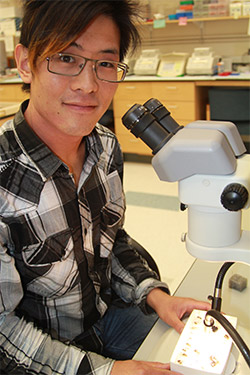
“Last spring, this field was covered with vegetation,” Hung says as he walks across the mostly dry Scripps Coastal Reserve on the bluffs overlooking Black’s Beach to survey bees, which appear less abundant than in previous seasons. “There’s no doubt that these bees will be affected by the drought. In coastal San Diego, we usually have a pretty good rainy season and good spring plant blooming. But in a bad year like this, the native bees might come out and not find anything to forage on. Their fate is so closely tied to the blooming schedule of plants that it’s hard to imagine that these pollinators wouldn’t be affected in some way.”
Hung and Holway discovered in their research over the past three years that as new home and other developments in San Diego fragment open space into isolated parcels, 35 percent of the species of bees native to those areas were lost. The researchers worry the current drought could exacerbate that trend, leading to the local extinction of many more native bees. “The fragments that James and I work in can be thought of as islands in a sea of development,” says Holway. “So if a species were to disappear from an isolated habitat fragment it could be difficult or impossible for it to recolonize.”
Local extinctions of native bees might not only affect the survival and diversity of the region’s plants but could also impact the pollination of agricultural crops. California’s $3-billion-a-year almond industry, the state’s number one agricultural export, spends $239 million annually to import more than one million honey bee colonies from other states to pollinate its almond trees due largely to the sharp decline of local honey bees from Colony Collapse Disorder. But a study published last year in the journal Science found that wild insects such as native bees may contribute 50 percent or more to the pollination of agricultural crops around the world, much more than experts realized.
“Studies are beginning to show that even in agricultural systems where honey bees are doing most of the work, they will do a better job if there are native bees around because honey bee movement patterns are more conducive to effective pollination when they are bumping into native bees as they go from flower to flower,” explains Hung.
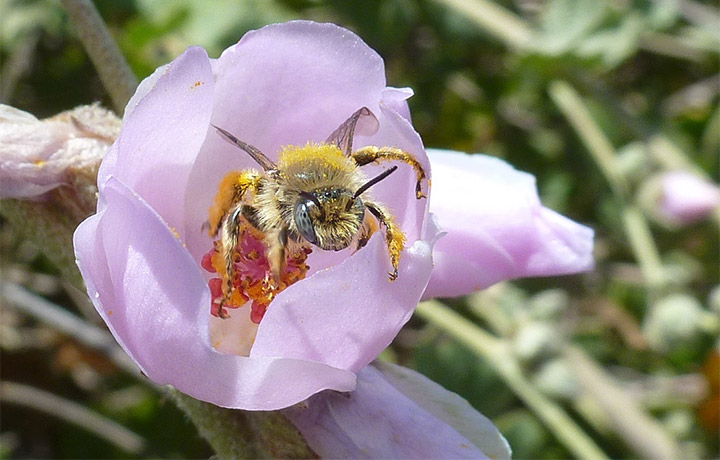
Stop and smell the roses—bee biodiversity revealed through flower watching
Why these economically and ecologically important insects are so underappreciated is probably due to the fact that people simply don’t know they exist. Stand over a wildflower for a minute and chances are good that black speck you may have at first dismissed as dirt, then assumed was a gnat or some other tiny bug once it started crawling, is probably a native bee in the process of pollinating the plant. It might seem incredibly simple, but standing over flowers is the main way Hung and some of the undergraduate students who’ve helped him have found the more than 350 native bee species in his collection over the past three years.
“The best way is to stand there and look at a flower and a bee will probably show up,” Hung says. Once he spots his quarry, it takes Hung only a second to capture the victim, using a rapid swoop of his insect net (he makes sure to finish the swing with a tennis-like follow through to assure the bees’ capture). Then he plops the insect into a plastic tube for the trip back to his laboratory.
Different kinds of native bees, if they’re “specialists,” favor specific plants—which is why, when Hung finds an unusual flowering plant, he’ll hang around for an extended period. Last year, Holway tipped him off about a rare flowering gooseberry he spotted in the Rose Canyon Open Space Park south of campus, so Hung hiked to the area and patiently stood over the flower for 20 minutes with net at the ready before he finally saw a bee. “I caught only two bees that day, but I was happy, because this was a very rare bee,” he explains. “It was the first record of that bee this far south.”
In Hung’s collection is the largest-known native bee in North America, the “valley carpenter bee,” as well as the smallest, a red, gnat-like creature known as Perdita minima, which burrows in the desert sand to lay its eggs and feeds exclusively on a tiny plant called Euphorbia. “We have the largest and smallest in North America in the same habitat,” he says proudly, “both in San Diego.”
An untapped mecca of buzzing bandits
While no one really knows why San Diego’s native bees are so diverse in color, appearance and size, Hung speculates the reasons may have something to do with the size, shape and abundance of the specific flowers from which they gather pollen and nectar. “Some bees have really long faces or super-long tongues, so they can stick their faces into long, tubular flowers,” he says. “Usually a large bee will forage on a large flower because it can get a lot of nectar and pollen from it.”
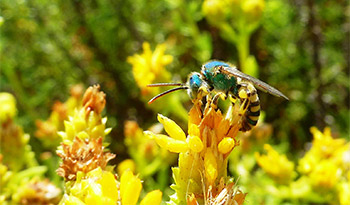
As for why our region is such a bee mecca, home for so many different species of native bees, Hung thinks it’s because San Diego’s coastal, desert and mountain environments are so diverse, relatively dry and largely free of freezing temperatures. “Our winters are so short that most of the year there’s something blooming,” he says. “Most of the bees live in tunnels underground or in wood, so having a long freezing season or a long rainy season is bad for them.”
Although wild bees are generally well known to taxonomists, with more than 20,000 described species around the world—more than the number of known birds, but far less than the number of known beetles—San Diego’s bee population strangely hadn’t gained much interest from biologists until Hung began his work. “San Diego as it turns out is relatively under-sampled with respect to its bee fauna,” says Holway, adding that it’s a mystery, given the native bees’ relatively large importance to the ecosystem and economy.
“A lot of earlier taxonomists who worked on bees worked in Arizona or New Mexico or in the Central Valley and mountain ranges of California,” says Hung. “But they’ve mostly stopped there, perhaps because their assumption has been that San Diego has pretty much the same stuff because our deserts look like Arizona or New Mexico and our coasts look like the coastline further north. But that’s not the case. There are a lot of new species here and that’s why I’m engaged in this effort—not only to determine their ecological impact, but to gain an inventory, a basic understanding of what’s out here, because it’s really hard to conserve what you don’t know.”
A one-man bee PR machine
In his collection, Hung has many undescribed bee species new to science, such as a parasitic bee he recently collected in the Anza Borrego desert. He’s photographed species of bees never before photographed in nature in places one wouldn’t expect, such as local parks like Mission Trails Regional Park. And in recent years, he’s become a kind of one-man, bee PR machine in an effort to educate the local community about the importance of the native bees that exist (quite literally) under our very noses. Just about every other month, he’s leading nature walks to search for bees in local parks, visiting elementary and high schools with his bees or lecturing to local nature and plant societies. He’s recently started a blog for anyone interested in the region’s native bees.
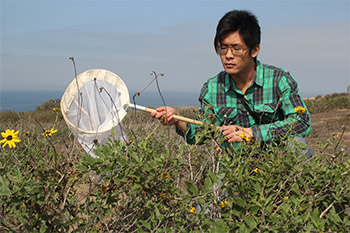
Like most modern-day biologists, Hung embraces a molecular approach to his research, submitting DNA sequence data from some of his unusual bees to an international database of living organisms. But in an age when biologists are more likely to focus on genetic sequences and biochemical pathways than systematics—the description and classification of living organisms—his work in revealing the hidden lives of San Diego’s bee population demonstrates that “old school” taxonomy still offers a lot of value to science.
“James is a graduate student with many scientific interests beyond pinning and identifying bees,” says Joshua Kohn, a biology professor who chairs the Ecology, Behavior and Evolution Section of the Division of Biological Sciences. “It amazes me that someone with so many interests has managed to become a museum quality bee systematist at such a young age. These are skills rapidly being lost, and ones that no modern technology will replace.”
Share This:
You May Also Like
UC San Diego is Strengthening U.S. Semiconductor Innovation and Workforce Development
Technology & EngineeringStay in the Know
Keep up with all the latest from UC San Diego. Subscribe to the newsletter today.



